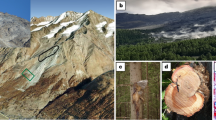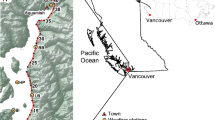Abstract
Geomorphic processes continuously shape mountain regions, with rockfall being one of the most widespread and frequent events. Its unpredictable and sudden occurrence poses major threats to settlements, human infrastructure and can even lead to the loss of life (Porter and Orombelli 1981; Bunce et al. 1997; Guzzetti 2000). In recent years, anthropogenic activities increasingly expanded into marginal regions. This development results in the construction of new infrastructure and settlements in exposed areas, leading to increased risk of casualties. In order to avoid future accidents, an accurate hazard assessment and risk analysis become more and more inevitable. Besides a comprehensive understanding of the process, risk evaluation requires the knowledge of past rockfall activity in space and time. Areas where rockfall occurs have to be identified, and the frequency and magnitude of events determined. As a result, rockfall has become one of the most intensely studied geomorphic processes in the alpine environment.
Access provided by Autonomous University of Puebla. Download chapter PDF
Similar content being viewed by others
Keywords
These keywords were added by machine and not by the authors. This process is experimental and the keywords may be updated as the learning algorithm improves.
Geomorphic processes continuously shape mountain regions, with rockfall being one of the most widespread and frequent events. Its unpredictable and sudden occurrence poses major threats to settlements, human infrastructure and can even lead to the loss of life (Porter and Orombelli 1981; Bunce et al. 1997; Guzzetti 2000). In recent years, anthropogenic activities increasingly expanded into marginal regions. This development results in the construction of new infrastructure and settlements in exposed areas, leading to increased risk of casualties. In order to avoid future accidents, an accurate hazard assessment and risk analysis become more and more inevitable. Besides a comprehensive understanding of the process, risk evaluation requires the knowledge of past rockfall activity in space and time. Areas where rockfall occurs have to be identified, and the frequency and magnitude of events determined. As a result, rockfall has become one of the most intensely studied geomorphic processes in the alpine environment.
However, the unpredictability of rockfall events poses major difficulties for a realistic assessment of the process. In the absence of a detailed, eyewitness history, dendrogeomorphology is the only method allowing for an adequate reconstruction of past rockfall parameters, such as rebound heights of rocks and boulders, or frequency, magnitude, and seasonality of events. Following mechanical impact, different tree species, e.g. European larch (Larix decidua), Norway spruce (Picea abies), silver fir (Abies alba) respond with the formation of specific growth features such as tangential rows of traumatic resin ducts, reaction wood, callus tissue, or abrupt changes in growth (Braam et al. 1987; Schweingruber 1996, 2001; Schneuwly et al. 2009). These growth features can be dated with intra-annual precision, allowing for the reconstruction of past rockfall frequencies with seasonal accuracy (Stoffel and Perret 2006). Determination of the main rockfall season and past activity patterns permits the identification of local triggers.
A total of 191 severely injured conifer trees were sampled at a case-study slope in Saas-Balen (Valais, Switzerland). The analysis of 50 years of rockfall history unravelled an ordinary background activity during most years and severe activity during exceptional event years (Fig. 1). The intra-annual distribution of rockfall events shows a peak in activity during the dormant period (early October – late May), and lowest activity during summer. Freeze-thaw processes are identified as the main ordinary rockfall trigger. On the slope, reconstructed rockfall frequency averages 1.02 events m−1 year−1. In addition, two major rockfall event years could be determined. In 1960, the rockfall rate attained 3.9 events m−1 and culminated in 6.6 events m−1 in the following year (1961). The second peak in rockfall activity is noted for 1995, when 5.1 events m−1 were reconstructed. Both events could be correlated with exceptional triggers. In 1960, a magnitude 5.3 earthquake (Mercalli intensity VIII) occurred 18 km away from the study site. In 1995, unusually heavy precipitation was recorded at the study site. In contrast, no long-term trend in rockfall activity could be detected. Spatial analysis of rockfall frequency revealed highest values (>4 events m−1 year−1) at the lateral boundary that is oriented towards the main rockfall source area (Fig. 1b). Values at the boundaries are higher and rapidly decrease inside the stand. Investigations on injury heights reveal a mean value of 0.85 m. The maximum rebound height attains 4.5 m, but two thirds of all impacts did not surpass 1 m. Spatial analyses on rebound height indicate highest values at the lateral boundaries of the study site (Fig. 2b). Rebound heights immediately decrease inside the forest, illustrating again the deceleration effect of the trees and the dampening effect of the changed surface conditions within the stand (Schneuwly and Stoffel 2008a, b). Spatial data on rockfall frequency and rebound heights clearly demonstrate the protection effect of forest against rockfall.
Reconstructed rockfall frequency for the last 50 years with the sample depth (ED = exposed diameter). There exists an ordinary background activity during normal years with exceptional activity in event years. In 1960, a magnitude 5.3 earthquake occurred in proximity, in 1995, a heavy precipitation event triggered the outstanding activity. No long term trend (gray line) is detectable
Spatial analysis of the rockfall activity and the bounce heights at the study site. (a) Highest rockfall frequency can be found at the lateral boundary that is oriented towards the main rockfall source area. (b) Highest rebound heights occur at both lateral boundaries. Rapidly decreasing values inside the forest are witnessing the protection effect of the forest against rockfall. Notice the shielding effect of a big boulder in lateral top position (black arrow)
Dendrogeomorphology has proven its high potential in rockfall research. Reconstructed data on rebound heights and seasonality can improve the general understanding of the process. Long-term data on frequency, magnitude as well as trigger identification substantially improves local risk assessment and allows more precise predictions on future rockfall pattern.
References
Braam RR, Weiss EEJ, Burrough A (1987) Spatial and temporal analysis of mass movement using dendrochronology. Catena 14:573–584
Bunce CM, Cruden DM, Morgenstern NR (1997) Assessment of the hazard of rock fall on a highway. Can Geotech J 34:344–356
Guzzetti F (2000) Landslide fatalities and evaluation of landslide risks in Italy. Eng Geol 58:89–107
Porter SC, Orombelli G (1981) Alpine rockfall hazards. Am Sci 69:67–75
Schneuwly DM, Stoffel M (2008a) Tree-ring based reconstruction of the seasonal timing, major events and origin of rockfall on a case-study slope in the Swiss Alps. Nat Haz Earth Syst Sci 8:203–211
Schneuwly DM, Stoffel M (2008b) Changes in spatio-temporal patterns of rockfall activity on a forested slope – a case study using dendrogeomorphology. Geomorphology 102:522–531
Schneuwly DM, Stoffel M, Bollschweiler M (2009) Formation and spread of callus tissue and tangential rows of resin ducts in Larix decidua and Picea abies following rockfall impacts. Tree Physiol 29:281–289
Schweingruber FH (1996) Tree rings and environment. Dendroecology. Paul Haupt, Bern, Stuttgart, Wien
Schweingruber FH (2001) Dendroökologische Holzanatomie. Paul Haupt, Bern, Stuttgart, Wien
Stoffel M, Perret S (2006) Reconstructing past rockfall activity with tree rings: some methodological considerations. Dendrochronologia 24(6):1–15
Author information
Authors and Affiliations
Corresponding author
Editor information
Editors and Affiliations
Rights and permissions
Copyright information
© 2010 Springer Science+Business Media B.V.
About this chapter
Cite this chapter
Schneuwly, D.M. (2010). Reconstruction and Spatial Analysis of Rockfall Frequency and Bounce Heights Derived from Tree Rings. In: Stoffel, M., Bollschweiler, M., Butler, D., Luckman, B. (eds) Tree Rings and Natural Hazards. Advances in Global Change Research, vol 41. Springer, Dordrecht. https://doi.org/10.1007/978-90-481-8736-2_16
Download citation
DOI: https://doi.org/10.1007/978-90-481-8736-2_16
Published:
Publisher Name: Springer, Dordrecht
Print ISBN: 978-90-481-8735-5
Online ISBN: 978-90-481-8736-2
eBook Packages: Earth and Environmental ScienceEarth and Environmental Science (R0)






